WEC
Arrival of the JOTA – 24 Hours of Le Mans
With JOTA becoming the first privateer team to win a race in WEC, It sets its sight at the next big step-overall victory at the 24 Hours of Le Mans.

The last time the WEC paddock went racing, A completely new name came at the top step – Hertz Team JOTA. With victory at the 6 Hours of SPA-FRANCORCHAMPS, JOTA became the first privateer team to taste the champagne of victory in the WEC. Now that they have broken one record, they aim for the next big win- the coveted TOP STEP at 24 HOURS OF LE MANS.
But how exactly did a small team who started in a modest Honda Integra, reach the most prestigous stage in endurance racing? This article is the story of the Arrival of the JOTA.
The Team
Started by Sam Hignett and John Stack in 2000, the first racing series they participated in was the 24 Hours of Nurburgring and the Spa 24hrs in a Honda Integra. Starting from 2000, they participated in various series like FIA Sportscar Championship, American Le Mans Series and Le Mans Endurance series.
They had their 24 hours of Le Mans debut with a Zytec 04S in the year 2005.

Piloted by Sam Hignett, Haruki Kurosawa and John Stack, they were running in fifth position until hour 22. After which they retired from the race due to an accident on track.
First Wins
The following years saw Team JOTA try its hands at Porsche Carrera CUP(2008) alongside the ALMS as well as the 24 Hours of the Le Mans. Come 2010, JOTA became the official partner of Aston Martin Racing. They participated in the Spa 24 Hours(1st place) and Britcar Silverstone 24 Hours(2nd place) with an GT4 Aston Martin.

At the 2011 24 Hours of Le Mans, JOTA entered with an Aston Martin GT2 in GTE Pro class but they wouldn’t finish the race due to engine issues. Their first taste of victory at Le Mans came at the 2014 race. With Simon Dolan, Harry Tincknell and Oliver Turvey at the wheel of a Zytec LMP2 machine, the British team was placed 5th overall and 1st in class.

Their next win would only come at the 2017 edition, this time partnered with Jackie Chan DC racing in LMP2 category in the Oreca 07 Gibson.
Porsche customer program
JOTA Sport continued to contest in the LMP2 category until 2023, when they announced their association with Porsche for a customer LMDh programme.

With the customer Porsche 963 delivered to JOTA only by the third round of Spa, they were on the back foot at the start of the season. But come the season end, at the last race in Bahrain, they were battling with giants like Ferrari for on-track positions.
2024 season
Porsche and JOTA started the first race of the season strong. It was an all Porsche podium in Qatar with JOTA finishing in 2nd place.
It was at the third race of the season when the number 12 Hertz Team JOTA car crossed the line first, ahead of a fast-charging factory Porsche (no.6). This made JOTA the first privateer team to win the overall race in WEC.
With the Porsche 963 looking strong as ever and Team JOTA riding high on enthusiasm from their win, they would very much like to do themselves one better and win the coveted race at Circuit De La Sarthe.
The Drivers
JOTA is fielding two cars- no. 38 and no. 12 for Le Mans.
#38 – Oliver Rasmussen, Philip Hansen, Jenson Button
#12 – William Stevens, Norman Nato, Callum Illot
With a competent crew and world-class drivers already present at their disposal, Team JOTA is looking strong for the weekend.
But the 24 Hours of Le Mans is much more than a test of the team’s skills. It tests the Car’s hardware, software and even the mental strength of the drivers to keep performing at their level best for a complete 24 hours. It’s a test the top people at Team JOTA would be looking to ace come Sunday evening.
Weekend Schedule
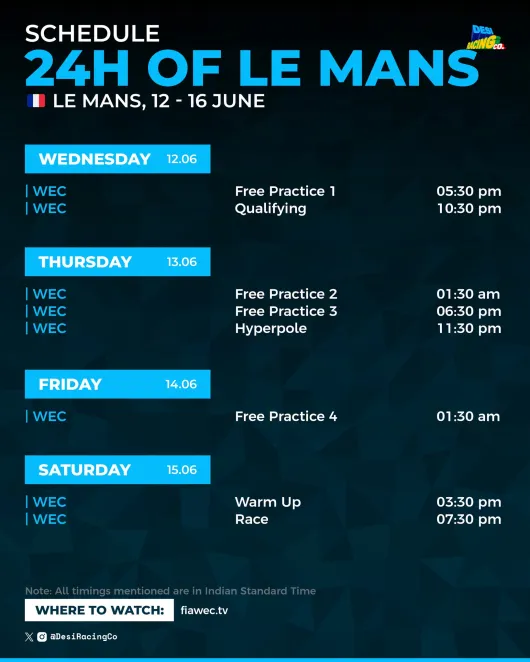
All the sessions will be streamed on Eurosport channel in India.
Click here for the complete entry list of the 24 Hours of Le Mans
WEC
6 Hours of São Paulo – WEC heads to Brazil

After wrapping up the series’ biggest race in Le Mans, the WEC paddock heads south to the Autódromo José Carlos Pace. The last time time WEC still held the 6 Hours of São Paulo was back in 2014. Now a decade later, WEC heads back to South America to start the second part of the season. In the both the classes, the competition is close as ever. Thus, there is a lot to look forward to. Here is the DRC preview for the 6 Hours of São Paulo.
The Title fight – Porsche X Ferarri X Toyota
Perhaps the biggest point heading into São Paulo is just how close the championship is at halfway through the season. In the manufacturers, Porsche is sitting at 108 points, 9 ahead of Ferrari (99), who themselves are 3 ahead of Toyota (96). Ferrari had a strong showing the last time out in France. (Click here to read our Le Mans report.) But the Italian brand is yet to win a race outside of La Saarthe. In order to win the overall championship, they would surely be looking to win on Brazilian soil.

Porsche had qualified at pole for the 24 Hours of Le Mans, but they struggled keep up with the pace come the race end. Porsche has had success at this track, in a very different car nevertheless. With a total of 104 points still up for grabs in the 2024 season, its anyone’s championship for the taking.

TOYOTA-Conway returns to #7
Mike Conway, the regular driver of the no. 7 Toyota hypercar was forced to sit out the 24 Hours of Le Mans after a cycling incident. Now, nearly a month later, He is completely fit and ready to jump back in the #7. His crew of the no. 7 car is still in the competetion for the drivers championship, and he will be working this weekend to get closer to that trophy.
The other Toyota, #8 was robbed of a podium finish in Le Mans after the #51 Ferrari nudged them into a spin in the closing stages of the races. This weekend, they would surely be looking to do themsselves one better and top the leaderboards.
BOP changes incoming for Brazil

Incoming this weekend is BOP changes. In the Hypercar category, the Isotta Fraschini has shed the most weight while teams like Ferrari and Toyota have taken up weight. However, when you take into account the ‘Power Gain’ system used by WEC to manage power beyond 250Kph, Ferrari and Toyota have managed to enter into increased power figures overall.
Ferrari and Toyota have gained 1.8% and 2.8% respectively. Meanwhile, Lamborghini, Alpine and Cadillac have each lost 1%, 1.3% and 1.5% after the threshold of 250kph. Isotta, Porsche and BMW have 0 gain or loss after 250 kph.
LMGT3 – Championship fight in full swing
If the Hypercar category is showing a close championship, the LMGT3 is not behind either. The top two teams (Manthey EMA and Mathey PureRXcing) sit on the exact no. of points, 75. The third placed team is Team WRT #31 placed just 2 points behind the table toppers.

The other team under Team WRT is the no. 46 BMW piloted by Ahmed Al Harthy, Maxime Martin and Valentino Rossi. They had a particularly difficult Le Mans as they crashed out in the Dunlop Chicane. They were showing good pace until the crash and surely they would be hoping to replicate atleast their racepace here in Brazil.
The other fan favourite team, Iron Dames is in good form as well. They have recently won in class at the 4 Hours of Imola in European Le Mans Series (ELMS) held durng 5-7 July.
At Interlagos, a track which is comparitively narrow for multiclass racing, it will be very thrilling for us fans to watch how different races unfold amongst different classes.
The Track

The Autódromo José Carlos Pace, or Interlagos as it is known amongst fans, is a track that tests every aspect of a car. The first 3 corners flows one into another effectively tugging at the downforce of the car. Coming immediately after is a straight that will be the hotspot for clearing backmarker traffic. Interlagos is a track where every corner flows into another, and with modern machines capable of eye watering speeds, the drivers will hardly get any time to rest. Setting up a car for this track will also be a workload as it requires both downforce and low drag conditions for the best performance. Hitting that sweet spot between the two will be important for the best results.
When and where to watch
In India, Eurosport will be broadcasting the races on TV.
WEC
Le Mans 24 Hours – Ferrari triumphs second year running

With a close contested Le Mans 24 Hours that saw the top 9 cars finish at the lead lap, it was anybody’s win for the taking. But come the race end at 19:30 IST on Sunday, it would be the no. 50 Ferrari who would cross the finish line first.
Celebrations down in Maranello
With strong showing in terms of reliability and performance from most of the hypercar field, it was brewing to be an interesting race.
Through the night, a less familiar yellow Ferrari was at the top, the No. 83 of AF Corse. However, its first trouble came in the form of a collision with no. 15 BMW LMDh of Dries Vanthoor. Kubica was given a 30-second penalty for causing this collision.
This was the end of the no. 83’s lead run.

That car would not finish as they retired due to a hybrid system issue.
But come the race end, it ultimately boiled down to a Toyota vs Ferrari battle for the win. No. 50 Ferrari found another obstacle in their course when its right hand side door came undone. This forced Nicklas Nielsen to come into the pits in the final 2 hours of the race, out of sequence with everybody else.
After Toyota completed its final pit stop of the race, it suspected the 50 Ferrari would need to stop once again. But as the end of the race came near, it became clear to Toyota that Ferrari were not stopping. They asked Jose Maria Lopez in no. 7 car to bring home P2.
With Nicklas Nielsen at the wheel, the no. 50 car co piloted by Antonio Fuoco and Miguel Molina crossed the finish line first with no. 7 toyota in second and last year’s winners no. 51 crew in third after serving a 5 second penalty given to them for spinning the no. 8 Toyota.

With this win, Ferrari has maintained its 100% win percentage at the Circuit De La Sarthe with the mighty 499P.
Toyota’s valiant effort
The start of the WEC season was not a strong showing by the Japanese crew. Hence, the Toyotas were not on the winners prediction of many people. When the qualifying session came to an end, Kamui Kobayashi in no. 7 car was looking quick. However he ended up making a rare mistake and spun his car causing a red flag. This meant his lap time was deleted. The no. 7 car started the race in 23rd (last amongst the hypercars).
Apart from this, the regular driver of no. 7 car, Mike Conway had injured himself before the race in a cycling accident. He was replaced by Jose Maria Lopez.
After the retirement of no. 83 ferrari, it looked like a three way battle between porsche, Ferrari and the Toyotas.

All through the night, the no. 8 Toyota was at the top of the standings. The other Toyota (no. 7) in the hands of Kamui Kobayashi was looking fastas well as he posted the fastest lap of the race at lap 254 (3:28.756). As the race neared its end, the Toyotas were looking well suited to challenge for victory. However trouble arrived for the no. 8 as no. 51 Ferrari nudged the Toyota into the Mulsanne corner. It fell to 6th position and everntually finished in fifth.
The no. 7 Toyota almost completed a last to first challenge as it split the red Ferrari on the podium.
Porsches still not back to the top step at Le Mans
Porsche has had a strong start to the season with a win in Qatar and a 100% podium appearance. Hence, going into the Le mans 24 Hours , they looked strong competitors for the overall win. This was further strengthened when the No. 6 Porsche in the hands of Kevin Estre took pole on Thursday.
However come the start of the race, they were passed quite quickly by the strong Ferraris.

This along with a wrong wet tyre change strategy meant the Porsche was not off to a strong start. However as the night rolled on, Porsche was looked as being the frontrunners for overall victory.
But trouble was back for Porsche. No. 4 car of Mathieu Jaminet, Felipe Nasr and Nick Tandy was out of the race as it crashed into the tyre wall at Indianapolis
The no. 5 and no. 6 were looking off the pace as the race got underway after the safety car period. They eventually finished in 6th and 4th respectively.
The mighty JOTA crew
In the qualifying session held on Wednesday night, Callum Illot at the wheel of the no. 12 JOTA lost control of his car in the esses. This crash did not looked heavy at first glance but when the mechanics looked closely, they found that the chassis of the car had been damaged.
This meant that if they wanted to field the no. 12 car in the race, they needed to build a car from scratch in just 24 hours! A usual build like this takes 3 whole weeks. But the mighty JOTA crew managed to complete it in just 24 hours. They did the shakedown on the Le Mans Airfield.
They eventually finished the race in P8 (no. 12) and P9 (no. 38)
Cadillac’s one lap pace
Cadillac might not appear as clear cut winners when you look at the final race standings. The no. 3 retired due to an engine issue and no. 311 fnished way behind the lead pack, 31 laps to be precise. Only the no. 2 Cadillac finished in P7 bagging points for the american outfit. Their one lap pace, however, looked mighty stronng. With factory Cadillacs finishing hyperpole in P2 (no. 3) and P3 (no.2), they certainly hoped for a better result out of the final race.
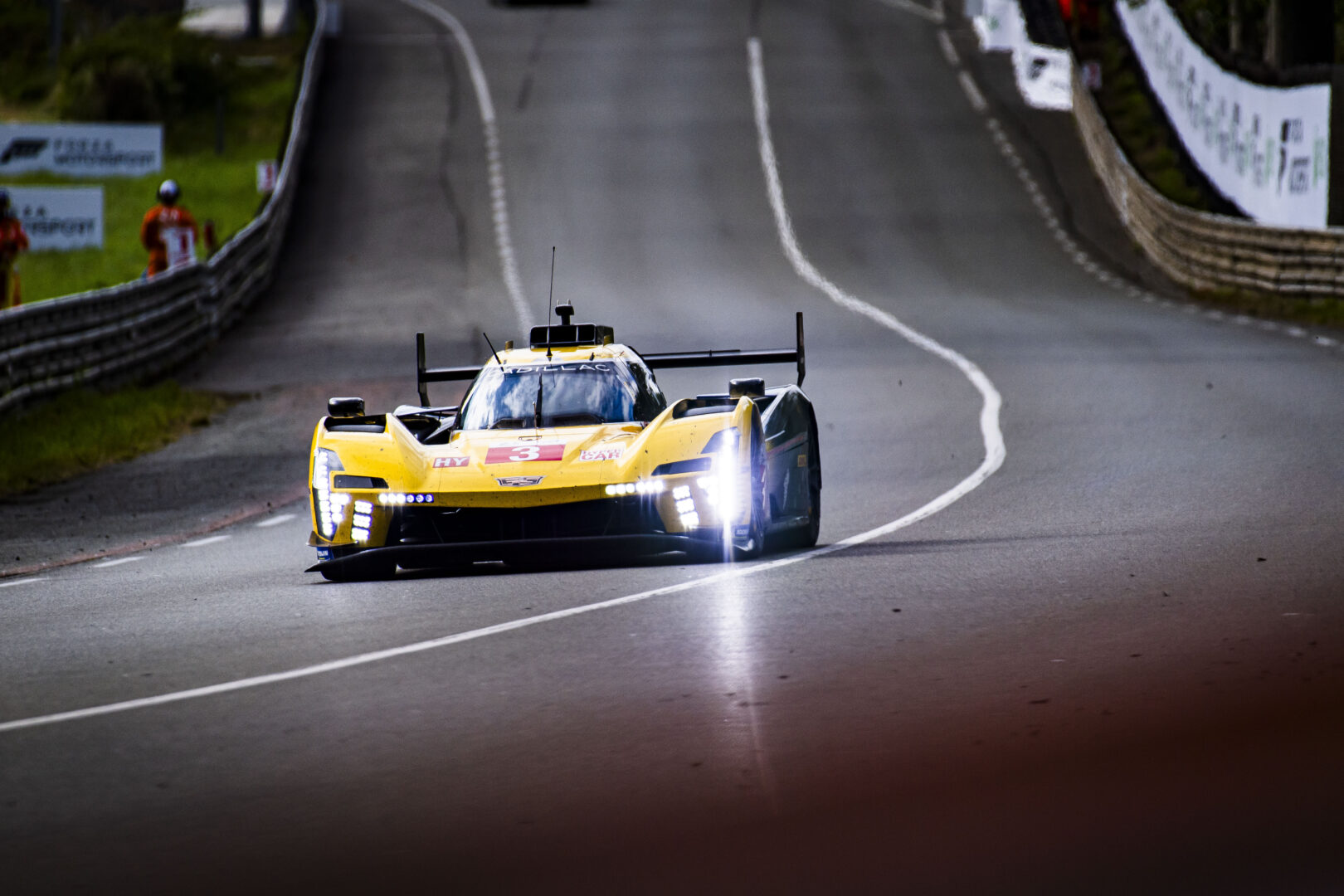
Lamborghini’s succesful debut
Iron Lynx’ operated Lamborghini effort had a pretty succesful debut at the 2024 Le Mans 24 Hours. With a race that tests every nook and crook of a car, the Italian outfit had both its cars across the finish line. The no. 63 car piloted by M. Bortolotti, D. Kvyat and E. Mortara even scored a point by finishing in P10. The other car no. 19 finished P13 with R. Grosjean, A. Caldarelli and M. Cairoliat the wheel.

Trouble for the BMW and Peugeot
Unlike Lamborghini, BMW’s debut was not pleasant. Out of the two cars, no. 15 car of Dries Vanthoor suffered an accident while getting lapped by no. 83 Ferrari of Kubica. This led to the no. 15 shunting into tyre wall and effectively out of the race.
The other BMW no. 20 started the race in 16th and climbed up to P10 before Robin Frijns lost grip in the ford chicanes and crashed into the tire wall 2 hours into the race.
They rejoined the track 30 minutes later and eventually finished the race 215 laps down on the leaders.
Peugeot had a lukewarm race as well. On one hand they managed to complete the entire 24 hours with both their cars just 2 laps down on the leaders, but they lacked pace to contest for the top points paying positions. The better of the Peugeots, no. 94, got beat by the Lamborghini SC63 for the final points position by a mere 8 seconds.

Eventually 94 Peugeot finished in P11 while 93 Peugeot finished in P12.
Alpine’s engine woes
Alpine was the team that took the biggest loss in the hypercar category. At the start of the race, both the Alpines were doing pretty good and no. 36 ran in P13 overall.
But come the fifth hour, both the cars were out of the race due to an engine issue .
In a race where fellow debutants like Lamborghini and even Isotta Fraschini managed to finished to complete 24 hours, Alpine managed to do only 5. The French team surely need to ask questions and come up with solutions.

Close fight in the LMP2 class
In the LMP2 category, no. 22 machine of United Autosports piloted by Oliver Jarvis, Bijoy Garg and Nolan Siegel finished in first place in the Le Mans 24 Hours. This was the second class win for the team. The top five teams in the LMP2 category after a complete 24 hours of racing was a mere 40 seconds! Last year’s Le Mans LMP2 winners Inter Europol competetion team came in P2 by 18 seconds.
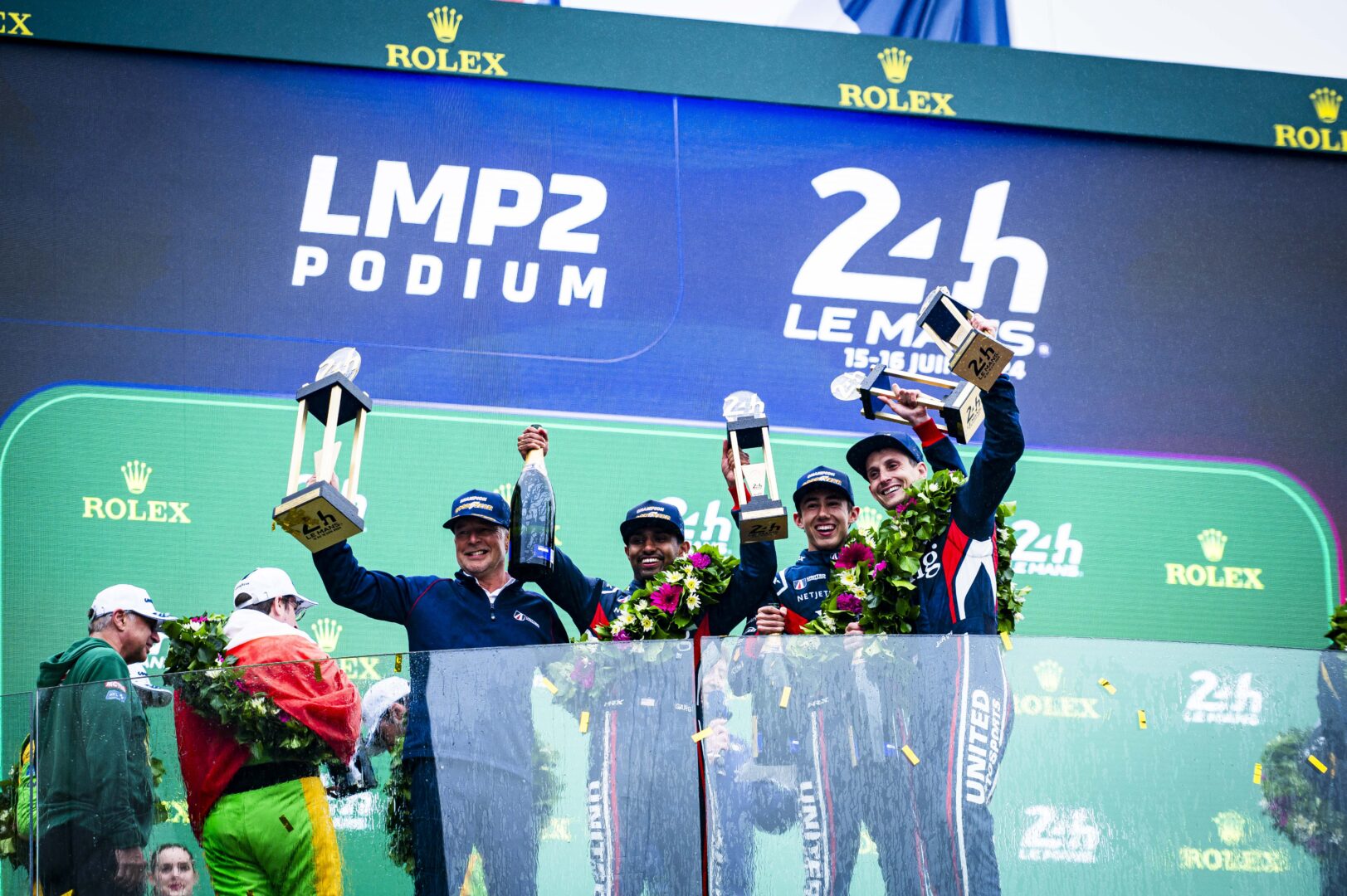
Manthey’s magic in LMGT3
In the LMGT3 class it was pure domination by the Manthey EMA no. 91 car. They finished a lap ahead of the second placed Team WRT BMW no. 31. This was Manthey’s debut at the Le Mans 24 hours in the LMGT3 era. The podium was rounded up by the Proton competetion no. 88 Mustang.

Elsewhere, the no. 46 BMW of Team WRT piloted by Ahmad Al Harthy, Valentino Rossi and Maxime Martin was leading the LMGT3 pack before a mistake by Al Harthy meant the car crashed into the tire barriers at the Dunlop chicane. This ended the no. 46′ race.

With a total of 23 hypercars starting the race and the top 9 hypercars finishing at the lead lap, praise shall also be showered at ACO, the conducting body of Le Mans 24 Hours for creating a true balance of power. Even in the lower classes, the racing was as close as ever. All these facts truly reflect that we are in the golden era of endurance racing.
Follow DesiRacingCO on Twitter to never miss a motorsport update!
WEC
Le Mans’ Laboratory: A Look Inside the Innovative Garage 56
Garage 56 at the 24 Hours of Le Mans showcases the race’s commitment to innovation, this special entry allows teams to explore groundbreaking technologies outside conventional rules. Continually pushing the boundaries of what’s possible in motorsport.

24 Hours of Le Mans, one of the most prestigious and gruelling motorsport events in the world, has a rich history of innovation and competition. Currently one of the most unique features of the race is ‘Garage 56’, a special entry slot dedicated to experimental cars that push the boundaries of automotive technology and performance. In the sea of “by-the-book” Hypercars and GT cars, Garage 56 offers a special testbed for the engineers and teams who see the art and potential of the road not taken.
History
Garage 56 was introduced in 2012 by the Automobile Club de l’Ouest (ACO), the organizing body of the 24 Hours of Le Mans. The aim was to encourage technological innovation and advancements at Circuit de la Sarthe and in motorsport as a whole. This unique slot allows one car to compete outside the usual regulations, provided it demonstrates significant technological innovation or environmental benefit.
2012 – Nissan DeltaWing
Garage 56 debuted with the Nissan DeltaWing. Originally created as a new generation IndyCar it came to Le Mans to compete. The car was fielded by All American Racers (constructor), Highcroft Racing (team) supported by Nissan. It featured a radical design with a narrow front track and a lightweight structure, aiming to achieve high drag efficiency and low fuel consumption. A four-cylinder Nissan turbo propelled the car.
The car qualified 29th with Marino Franchitti, Michael Krumm and Satoshi Motoyama driving. While qualifying was pleasant to the project, the race wasn’t as much. The car was retired after 75 laps following an accident after a collision with #7 Toyota TS030 Hybrid.

2013 – GreenGT H2
The GreenGT H2, a hydrogen fuel cell-powered car, was selected for the 2013 race. However, it did not participate due to developmental issues that prevented it from being race-ready in time. It highlighted the potential of hydrogen fuel cells as a sustainable energy source for motorsport.

2014 – Nissan ZEOD RC
Ben Bowlby saw the successor to his Deltawing to be the ZEOD RC (Zero Emission On Demand Racing Car). Once again backed by Nissan and fielded by Nismo, this time the car was powered by a hybrid electric drivetrain with lithium-ion batteries and a 3-cylinder Turbo engine, producing a total output of 695bhp.
Driven by Lucas Ordóñez, Wolfgang Reip, Satoshi Motoyama, the car qualified 27th, and managed to set a lap using electric power in the warm-up, which accomplished the goal of the project to “set a purely electric lap time at racing speeds”. Although, a gearbox issue would plague the car and would eventually force the car to retire on lap five.
Panoz and Ganassi sued Bowlby and Nissan over use of intellectual property due to the similarities with the DeltaWing, the matter was eventually settled out of court in 2016.

2015
2015 would see the garage 56 empty due to the nominated entry of Welter Racing, a biomethane-fuel prototype fell behind schedule because of funding issues. ACO later determined that none of the candidates were unfit.
2016 – Morgan LMP2 SRT 41 By Oak Racing
2016 would be a truly beautiful and heart warming year for Garage 56 as it would welcome a project led by Driver Frédéric Sausset, a quadruple amputee. The SRT 41 LMP2 was modified to allow Sausset to drive using a specially adapted control system, Sausset operated a throttle and braking system which with his thighs, while the steering column was directly attached to his right arm limb. His teammates would race the car normally.
The team would Qualify 32nd and finish a highly respectable 38th setting multiple records along the way including being the first Garage 56 car to finish the race, highlighting advances in accessibility and inclusivity in motorsports, demonstrating that high-performance racing is accessible to all. The team found its place in the hearts of motorsports fans all across the globe.

2017 – 2020
These few years would see numerous attempts including the failed return of Welter Racing and Perrin with the Project 424, an LMP1-based electric car with an autonomous driving mode.
But ultimately ACO would once again deem the candidates unfit and not mature enough to race. 2020 would see itself as a victim of the COVID-19 pandemic.

Credits: racecar-engineering.com
2021 – La Filiere by SRT 41 Oreca 07 LMP2
2021 welcomed Frederic Sausset once again to Garage 56, this time fielding a specially modified Oreca 07 Gibson LMP2 car with a lineup of three disabled drivers. Transcending barriers Sausset would this time round have not one but two drivers, paralyzed from the waist down racing his car.
The team would Qualify 29th and finish an incredible 32nd once again defying all odds and in the process the two disabled drivers became the first disabled teammates to compete and finish in the history of the race.

2022
Garage 56 would once again remain empty.
2023 – Chevrolet Camaro ZL1 StockCar
Nascar, to celebrate its 75th anniversary took the Chevrolet Camaro ZL1 StockCar run by Henderick Motorsports, its most successful team. The modified Stockcar would be driven by 7x Cup champion Jimmie Johnson, 2009 F1 world champion Jenson Button and 2010 Le Mans winner Mike Rockenfeller.
The car was quite different to the traditional machines that normally graced the track, in it’s sheer size and brute force produced by it’s incredible V8. It truly was a Goliath in the sea of Davids, but this story ends differently; the team would qualify and finish a very respectable 39th putting up a good fight with the GTEs. While the GTEs had a clear advantage in the corners, the Chevy would thunder down the straights.

Future
As we look into the future, Garage 56 continues to be a beacon for innovation in motorsports. It offers a unique platform for testing and demonstrating new technologies that may eventually become standard in racing and commercial vehicles.
“Le Mans has always been a crucible for innovation. Garage 56 gives inventors and engineers a chance to dream big and bring those dreams to life in a way that can inspire the entire automotive world.”
Don Panoz, Founder of Panoz Motorsports
As automotive technology continues to evolve, Garage 56 entries will likely explore new frontiers in electric propulsion, autonomous driving, advanced materials, and more. Thus maintaining its role as a crucible for the future of racing technology and the broader goals of sustainability and inclusivity in motorsport.

 Indian Motorsports5 months ago
Indian Motorsports5 months agoMIC to host Indian Racing League and Indian F4 in 2024.

 Formula 14 months ago
Formula 14 months agoSpanish Grand Prix 2024: European triple-header kicks off at Circuit de-Catalunya Barcelona

 Formula 15 months ago
Formula 15 months agoF1 Revival in South East Asia: Racing Returns?

 Indian Motorsports3 months ago
Indian Motorsports3 months agoSourav Ganguly becomes owner of Kolkata Royal Tigers

 Formula 15 months ago
Formula 15 months agoCanadian GP 2024 Preview: Can Red Bull Rebound Against Surging Ferrari and McLaren?

 Formula 13 months ago
Formula 13 months agoGIFT City’s Formula 1 Racetrack Plans Hit a Roadblock

 WEC4 months ago
WEC4 months agoDriving Change: The Inspiring Journey of Iron Dames in Motorsport

 Formula 17 months ago
Formula 17 months agoFancode: Everything you need to know before the Bahrain GP














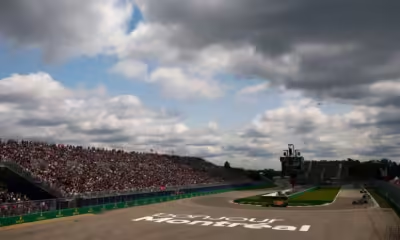



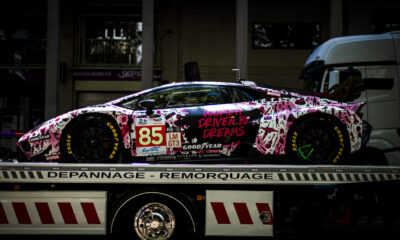



You must be logged in to post a comment Login